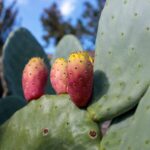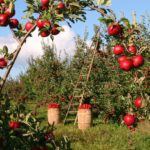Have you ever been captivated by the sight of a pineapple guava, with its emerald-green skin and sweet aroma? Have you ever wondered how to grow and care for one in your own garden? Pineapple guavas, also known as Feijoas, are unique and delightful fruits that can be an interesting addition to any garden.
The pineapple guava is an attractive, low-maintenance plant that produces fragrant flowers and sweet fruit. In this article, we’ll explore how to grow and maintain a pineapple guava to ensure it thrives in your garden. We’ll cover everything from planting and pruning to harvesting the delicious fruit.
With a little know-how and some effort, anyone can successfully grow and care for pineapple guava. Whether you’re looking for a beautiful addition to your landscape or hoping to enjoy the delicious fruit it produces, this guide will provide all the information you need.
1.Tlocation/Climate
Pineapple guava is a truly remarkable plant – one that can take your outdoor living space to the next level. With its sweetly scented and edible fruit, it’s no wonder this darling of the garden is becoming increasingly popular. But for all its greatness, there are certain things you’ll need to know about growing and caring for pineapple guava to ensure its success.
First and foremost, pineapple guava is a tropical plant that thrives in warm climates with temperatures between 60°F and 85°F. It should be planted in an area that receives full sun or filtered light all day long. If you live in a cooler climate, you may be able to grow this beauty in containers so you can bring it indoors during cold weather months.
Planting pineapple guava in well-draining soil is essential for proper growth, but it’s also important to supplement soil with compost or fertilizer so the tree has enough nutrients to produce healthy fruit. Additionally, adding mulch around the base of the tree helps retain moisture while controlling weeds. With thoughtful attention paid to these factors, your pineapple guava will surely flourish!
2.Tsoil Requirements
Soil requirements for pineapple guava are not overly demanding, and fairly forgiving. As the old saying goes, “the soil is the foundation of success” – and this rings true here. Just like a house needs a strong foundation to stand tall, so too does your feijoa plant.
The ideal soil for pineapple guava should be well-drained and contain plenty of organic matter. It should also have a slightly acidic pH level, around 5.5-6.5. If your soil doesn’t meet these criteria, don’t worry – you can always add amendments like peat moss or compost to help get it up to snuff!
You can also add mulch around the base of your feijoa plant to help keep the soil from drying out too quickly and retain moisture more easily. This will help ensure that your plant gets all the nutrients it needs in order to thrive! With these tips in mind, you’re well on your way to growing a healthy pineapple guava tree with strong roots and abundant fruit.
3.Twater Requirements
Water is the lifeblood of pineapple guava, like a river to a city. Without it, the plant would quickly become parched and dry up. To keep your pineapple guava healthy, here are some water requirements you should be aware of:
•tWatering frequency: Water your pineapple guava daily or every other day in the summer months, and reduce watering to once every 2-3 days during autumn. During winter, water only when the soil is dry.
•tAmount of water: When you do water, ensure that you give the plant enough to thoroughly moisten the soil. A good rule of thumb is to provide a gallon of water per square foot of planting area.
•tTime of day to water: It’s best to water in the morning so that the leaves have ample time throughout the day to dry off before nightfall. Doing this reduces any potential for fungal diseases caused by moisture on the foliage staying overnight.
These are just some basic guidelines for proper watering habits; always use your judgement based on weather conditions and how dry your soil feels if you’re unsure about how much or often you should be watering your pineapple guava. With proper care and attention, you’ll have a happy pineapple guava tree in no time!
4.Tfertilizer Requirements
Fertilizer is an important part of growing pineapple guava, as it provides the necessary nutrients to help the plant thrive. If you’re looking to get the most out of your pineapple guava, here are a few points to keep in mind:
First, you should use a balanced fertilizer with equal parts nitrogen, potassium and phosphorus. Applying this fertilizer twice annually is recommended — once in early spring, and then again in mid-summer — for optimal growth results. Additionally, you can apply a slow-release fertilizer throughout the summer months for added nutrition.
Second, avoid using too much fertilizer as it can cause leaves to yellow and stunt growth. When applying fertilizer, be sure to follow the directions specified on the label as each brand will vary in its requirements. Third, be sure to avoid fertilizing when temperatures are over 90°F or low temperatures below 32°F as this can harm your plants. Lastly, allow soil to dry out between applications — usually approximately two weeks — otherwise roots may burn from too much moisture.
With careful consideration of these four points when fertilizing pineapple guava, you’ll be rewarded with healthy plants that will continue to yield delicious fruit season after season. Now that we know about pineapple guava’s fertilizer requirements let’s look at how we can maintain our plants through pruning and training.
5.Tpruning And Training
Upon examining pineapple guava plants, it is evident that they require pruning and training. Pruning can be used to improve the overall shape of the shrub, and training encourages new growth as well as providing support for existing stems. It’s worth considering whether pruning and training is necessary for your pineapple guava before jumping in so you don’t accidentally damage the plant.
There are several different methods of pruning and training pineapple guava plants which can help you achieve the desired shape or size. Light pruning should be done in late winter or early spring, while more extensive pruning can take place in late summer or fall when flower buds are visible. When training a pineapple guava, an espalier pattern works best – this involves arranging the stems horizontally on a trellis or wall so that they form a lattice-like pattern.
To ensure good results when pruning and training your pineapple guava, make sure to use sharp tools that have been disinfected with rubbing alcohol to prevent disease transmission. It’s also important to remove any dead or diseased branches at the same time – this will help keep your plant healthy and promote better growth over time. With proper care and attention, you’ll soon have a beautiful pineapple guava bush!
6.Tpests & Diseases
Pineapple guava can be a great addition to any garden, but it’s important to know what pests and diseases could potentially affect your feijoa. From leaf spots to root rot, here are 6 common issues that could arise when growing pineapple guava:
- Bacterial Leaf Spot – This disease is caused by bacteria and is most common in warm, wet weather. Symptoms include dark lesions on the leaves that may cause them to yellow or drop off the plant.
- Root Rot – If not addressed quickly, root rot can eventually kill the plant. The best way to prevent it is to make sure you’re planting in well-draining soil and avoiding overwatering.
- Scale Insects – These pesky sap-sucking insects attach themselves to the leaves and stems of your feijoa and feed on the sap, which can weaken and even kill the plant if left unchecked.
- Aphids – These tiny insects suck sap from the leaves of your pineapple guava, causing discoloration and distortion of new growth as well as honeydew secretions that can lead to sooty mold growth on the leaves or fruit.
- Spider Mites – These tiny mites create webs between the leaves and stems of your feijoa which reduce photosynthesis efficiency and stunt growth of new leaves or shoots.
- Whiteflies – These small white flying insects feed on your feijoa’s sap which causes yellowing of the foliage and stunted growth as well as honeydew secretion which can lead to sooty mold growth on foliage or fruit.
Staying vigilant for these potential threats is key for keeping your pineapple guava healthy; regular inspections of plants for signs of infestation are recommended for early detection before an issue becomes too widespread for treatment to be effective. Additionally, pruning away affected parts of plants immediately can help limit pest populations before they become unmanageable. With a little dedication, these pests and diseases don’t have to ruin all your hard work growing this beautiful plant!
7.Tpropagation
Propagating pineapple guava is relatively easy, and can be done in several ways. If you’re up for a challenge, you can try to propagate feijoa from seed. It’s important to note that while this method may take longer and yield less reliable results, it allows you to create unique plants with unusual characteristics. Alternatively, if you want a guaranteed result, you can propagate feijoa by cuttings or layering. Here’s how:
•tCuttings: Take 3–4 inch stem cuttings from the tips of the branches in late spring or early summer. Plant them in a well-drained potting mix and water moderately until new growth appears.
•tLayering: This technique works best on branches that are close to the ground but not completely on it. Bury these sections of stem—leaving two sets of leaves above the soil surface—and cover with soil and mulch. Keep well-watered until roots form at the buried node.
• Air Layering: If there are no branches close enough to the ground or if propagation by cutting isn’t working out, air layering can be a great alternative! To do this, make an incision partway through a branch and wrap it with damp moss before covering it with plastic wrap or aluminum foil secured with tape or string. Once roots have developed (usually after 2–3 months), remove it from the parent plant and pot it as normal!
No matter which of these methods you choose, propagating feijoa is sure to be an enjoyable experience that leads to even more pineapple guava plants for your garden! With proper care and attention, your propagated plants will soon become healthy specimens ready for harvesting.
8.Tharvesting
Harvesting pineapple guava is a rewarding activity that can give you a sweet and juicy reward. With proper care, you can enjoy the tangy-sweet flavor of this unique fruit from your own garden. Here are some important tips to keep in mind when harvesting pineapple guava:
• Pick fruit when it has turned yellow or greenish yellow. • If you pick too early, the fruit will be sour and not as tasty. • When ripe, the fruit should easily pull away from the stem with a gentle tug. • Avoid picking fruits that have soft spots or signs of damage.
As with other types of guavas, pineapple guava must be picked at just the right time for maximum sweetness and flavor. Start checking the fruits regularly once they reach full size. The ones with yellow color around their edges are almost ready to harvest. You can even taste test a few to determine if they’re ripe enough for harvesting. If harvested at peak ripeness, the fruits can usually be stored in the refrigerator for up to two weeks before needing to use them up or freeze them for future use.
Before moving on to storage, make sure you select only healthy-looking fruits that have reached their peak ripeness, so you get the best results from all your hard work!
9.Tstorage
Imagine, if you will, the most delicious fruit ever harvested from your garden! Pineapple guavas are truly a treasure trove of flavor and nutrition! But how do you store these succulent fruits in order to enjoy them at their peak? Here are 9 storage tips to keep your pineapple guava harvest fresh and tasty:
- Refrigerate ripe pineapple guavas as soon as possible.
- Place the fruit in a plastic bag with some paper towels to absorb moisture.
- Store in the crisper drawer of your refrigerator for up to two weeks.
- If you need to store pineapple guava for longer than two weeks, place them in an airtight container and freeze them for up to six months.
Storing pineapple guava properly is the key to preserving its flavor and texture, so it’s important that you follow these steps carefully! Not only will this ensure that you get the most out of your fruit, but it also helps prevent spoilage of any uneaten fruits or leftover pieces that might be saved for later use. Plus, storing pineapple guava correctly can help reduce waste, making it easier on your wallet and our planet!
So don’t let your precious harvest go to waste – take the time to prepare and store pineapple guava properly so that you can enjoy its sweet taste whenever you want! With just a few simple steps, you’ll have fresh fruit ready whenever your cravings hit – no matter when they come! And now it’s time to turn our attention towards tuses…
10.Tuses
Did you know that pineapple guava is one of the few fruits that can be eaten both fresh and cooked? This versatile fruit has a plethora of uses, ranging from cakes, jam, juice and even wine! With its sweet taste, pineapple guava can be used in a variety of ways to satisfy your culinary desires.
Pineapple guava can also be used as a garnish or an ingredient in salads. The leaves also have a range of uses, including being boiled and served as tea. The fruit can also be used to make syrup or jelly, which makes it perfect for a range of desserts. Additionally, pineapple guava can be mashed into smoothies or frozen and blended into sorbets.
Finally, pineapple guava is also great for skin and hair care products. One can make homemade face masks and shampoos with this sweet-tasting fruit! It is packed full of antioxidants that are known to help reduce inflammation and ward off wrinkles. With all these wonderful uses, why not give pineapple guava a try? Moving on to tips for growing the plant itself…
11.Ttips For Growing Pineapple Guava
Growing pineapple guava is a rewarding experience that can bring fragrant, delicious fruits to your garden. If you’re looking to cultivate this unique and tasty fruit, there are a few helpful tips to keep in mind.
First off, pineapple guava grows best in climates with mild winters and hot summers. Make sure the soil drains well and supplement it with organic matter like compost before planting. Pineapple guava doesn’t require much pruning or maintenance besides occasional fertilization during the growing season. It’s also important to note that pineapple guava needs plenty of sun – at least 6 hours of direct sunlight per day – in order to thrive.
Finally, it’s crucial to water your pineapple guava regularly for optimal health. Water deeply once or twice per week depending on the weather during the summer months, but reduce watering during winter when the plant is dormant. With these guidelines in place, you should have success growing pineapple guava in your garden!
Now that we’ve gone over these tips for cultivating pineapple guava, let’s move on to discussing some of the common varieties available today.
12.Tcommon Varieties
Growing pineapple guava is like painting a picture; each variety adding its own unique stroke of color. While there are many types of pineapple guava, some of the more popular varieties include Acca sellowiana ‘Coolidge’, Acca sellowiana ‘Red Beauty’ and Feijoa sellowiana. Each one offers its own unique characteristics and requirements for growing in different climates, making the task of selecting the right plant a bit daunting.
Acca sellowiana ‘Coolidge’ is an evergreen shrub with yellow flowers that turn into edible fruit with white flesh. It requires full sun to partial shade and soil that drains well. This type of pineapple guava is hardy and can tolerate temperatures down to 10°F (-12°C). A great choice for those living in cooler climates.
Acca sellowiana ‘Red Beauty’ is a larger shrub with larger fruits than ‘Coolidge’. It has beautiful red flowers that turn into large, bright red fruits when ripe. This variety prefers full sun and moist, yet well-drained soil, so it may need extra watering during dry times. Red beauty is hardy to around 20°F (-7°C). With its vibrant colors, this type of pineapple guava will definitely add pizzazz to your garden!
Pineapple guavas are not only tasty but also attractive plants that can add interest to your garden or landscape. Whether you’re looking for something small like Acca sellowiana ‘Coolidge’ or something larger like ‘Red Beauty’, choosing the right type of pineapple guava should be easy once you know your climate and what works best in it. Now that you have a better understanding of common varieties, let’s move on to discussing design ideas…
13.Tdesign Ideas
Coincidentally, designing a garden that includes pineapple guava is as enjoyable as watching it thrive in your yard. With proper care and planning, you can easily create a beautiful outdoor space that features this unique plant. Here are some design ideas to get you started:
• Incorporate pineapple guava into a rock garden. The waxy foliage and colorful flowers offer great contrast against the grey tones of stones.
• Plant multiple pineapple guavas in an open area for a dramatic effect when they’re in bloom. This will also attract pollinators like bees.
• Add some height with trellises or arbors covered with pineapple guava vines. It looks especially nice when tendrils are trained to climb walls or fences.
These design ideas can help you create an eye-catching landscape that showcases the beauty of pineapple guava while providing its many benefits. As you plan your garden, don’t forget to consider companion planting with other plants that will help encourage healthy growth and development of the pineapple guava bushes.
14.Tcompanion Planting
You may be wondering why companion planting matters when growing pineapple guava. While it might seem like a minor detail, companion planting is an important factor to consider when caring for your pineapple guava. By understanding which plants grow best alongside pineapple guava, you can create a thriving garden that will provide years of enjoyment.
Companion planting refers to the practice of selecting plants that benefit each other in terms of growth, pest control, and nutrient needs. It’s a great way to create a balanced ecosystem in your garden and maximize the yield of your pineapple guava plant. For example, planting marigolds around your pineapple guava will help keep away pests like aphids, while also providing additional nutrients to the soil. Additionally, adding nitrogen-fixing plants such as clover can help protect and nourish the soil where your pineapple guava grows.
These are just some of the many ways that companion planting can contribute to the success of your pineapple guava tree. With careful planning and selection of compatible plants, you can create a lush and vibrant garden that will thrive for years to come! As you continue reading through this guide on how to grow and care for pineapple guava, keep in mind these tips on companion planting so you can ensure maximum success with your own fruit tree.
15.Ttroubleshooting Problems
Troubleshooting problems with pineapple guava is like solving a puzzle; the pieces must fit together just right. The first step is to identify the issue. If you notice yellowing leaves, it may be caused by a nutrient deficiency, or too much water or sun. Insects and diseases can also be culprits. Once you have identified the problem, you can take steps to remedy it with the appropriate remedies.
Remedies for pineapple guava issues vary based on what is causing the problem. For example, if there is a nutrient deficiency, fertilizing with a balanced fertilizer will usually help. For insects and diseases, natural solutions like insecticidal soap and neem oil can help keep them in check. If too much sun or water is an issue, simply adjust your watering schedule or provide more shade to the plant.
To prevent future issues from occurring, make sure that your pineapple guava plants are planted in well-draining soil in an area with plenty of sunlight and away from harsh winds. If possible, use companion plants like rosemary to naturally deter pests and diseases. With the right care and attention, your pineapple guava will thrive!
Frequently Asked Questions
What Is The Best Time Of Year To Plant A Pineapple Guava?
When it comes to planting pineapple guava, timing is everything. The best time to plant this delicious fruit is in the spring, when the temperatures are mild and consistent. Planting your pineapple guava during this time ensures that the roots will have plenty of time to establish themselves before the hot summer months arrive. Additionally, you should wait until all danger of frost has passed before you plant your pineapple guava.
It’s important to note that if you’re planting more than one pineapple guava tree, be sure to space them out about six feet apart so that they can get enough sun and air circulation for optimal growth. It’s also beneficial to add a layer of mulch around each tree as this will help keep the soil moist and help retain nutrients. Once planted, be sure to water your trees regularly, as they will need plenty of water until they become established.
The care and maintenance required for a healthy pineapple guava is minimal but important nonetheless. Make sure you prune any dead or damaged branches off the tree throughout its life cycle and fertilize it twice a year with an organic fertilizer. This way, you’ll ensure your trees are happy and healthy year-round!
How Often Should I Water A Pineapple Guava?
If you’re looking to add a tropical feel to your garden, pineapple guava is the perfect plant to get. And, with proper care and watering, it can provide beautiful blooms and tasty fruit! But how often should you be giving your pineapple guava a drink?
Well, generally speaking, pineapple guava will appreciate a good soaking once or twice a week during the warmer months. During periods of extreme heat or when temperatures are consistently high, you may need to increase your watering frequency to every other day. For optimal results, try to water in the morning or evening when temperatures are cooler. A good rule of thumb is that if the top inch of soil feels dry then it’s time to water.
Pineapple guava loves moist soil but it doesn’t like wet feet so be sure not to over-water and let the soil dry out between waterings. Also remember that container plants will require more frequent watering since their root systems are much smaller than those planted directly in the ground. If you want your pineapple guava bush to thrive and bear delicious fruit for years to come, make sure it gets enough water at just the right times!
Are Pineapple Guavas Self-Pollinating?
Did you know that the pineapple guava is a self-pollinating fruit? This seemingly small detail might be overlooked in the grand scheme of caring for this tropical plant, but it makes a big difference. After all, who wants to spend time hand-pollinating their plants when they don’t have to?
Irony alert: Despite its name, the pineapple guava isn’t actually related to either pineapple or guava—it’s a completely different species! Yet this unique and delicious fruit still has some similarities to its other two counterparts: it also needs plenty of sunshine and lots of water in order to thrive.
But you won’t need to worry about pollination when growing your own pineapple guava, which is an added bonus! The fact that these fruits are self-pollinating means that you can enjoy the deliciousness without having to spend extra time taking care of them. So if you’re looking for an easy way to liven up your garden with tropical flavor, look no further than the pineapple guava!
How Can I Tell When A Pineapple Guava Is Ripe?
The sweet, tart aroma of a ripe pineapple guava is like a summer breeze on a warm day. If you’ve ever wondered how to tell when one of these delicious fruits is ready for picking, the answer can be found in their physical characteristics. As with most fruits, pineapple guavas become more fragrant and change color as they ripen.
Look for a yellow-green to yellow-red color and an orange blush on the skin of the fruit. It should also feel soft but not squishy when gently squeezed. You may also see some browning around the stem which indicates that the fruit is ripe and ready for picking. The fruit will have a sweet, slightly tart flavor at this stage too.
So if you’re looking to grow your own pineapple guava tree or buy fruit from the store, keep an eye out for these signs of ripeness! Not only will it ensure you get to enjoy its unique flavor, but it’ll also yield better results in terms of nutritional content – as eating under-ripe pineapple guavas can be quite sour and difficult to digest.
Can Pineapple Guavas Be Grown In Pots?
Imagine the sweet-tart, tropical flavor of pineapple guava in a container on your patio! Growing pineapple guavas in pots is an easy and rewarding endeavor for any gardener looking to add a little exotic flavor to their outdoor living space.
The benefits of growing pineapple guavas in pots are clear: it’s easier to monitor and control soil moisture levels, and the plant can be moved around as needed or brought indoors during cold winter months. But, there are a few things you need to know before planting pineapple guava in a pot.
First, select a pot that’s at least 12 inches deep and wide so that the tree has plenty of room to grow roots. You’ll also want to use well-draining soil with added organic material like peat moss or compost. Lastly, make sure the chosen pot will receive enough sunlight – this fast-growing fruit tree needs at least six hours of direct sun each day.
With proper care and attention, your fruiting pineapple guava tree will yield delicious fruit for many years to come! To ensure success, water regularly (but not too much) and fertilize every two weeks with an all-purpose fertilizer. And don’t forget – when the fruits start ripening in late summer or early fall, you’ll know it’s time to pick them!
Conclusion
Pineapple guava is a wonderful addition to any garden. Not only does it provide delicious fruit, but it is also an attractive and hardy shrub that can be enjoyed all year round. With the right care and attention, pineapple guavas can produce generous harvests for many years to come.
To get the best out of your pineapple guava, plant it at the right time of year and ensure that you water it regularly. Be aware that not all pineapple guavas are self-pollinating and so you may need to hand-pollinate flowers if you want a good crop of fruit. After harvesting, you will quickly discover how delicious this fruit is – sweet like candy yet tart like lemonade!
So, why not make your garden even more beautiful by planting a pineapple guava? It’s like adding a splash of sunshine to your landscape – full of flavor, color, and life! With proper care and attention, this special fruit tree will be sure to bring joy for many seasons to come.





























